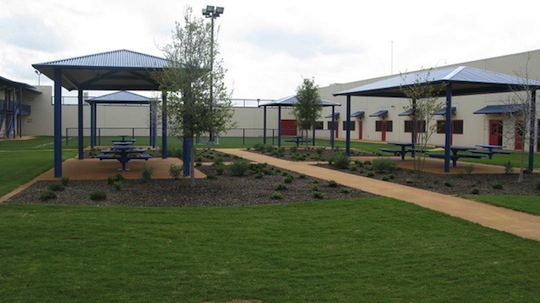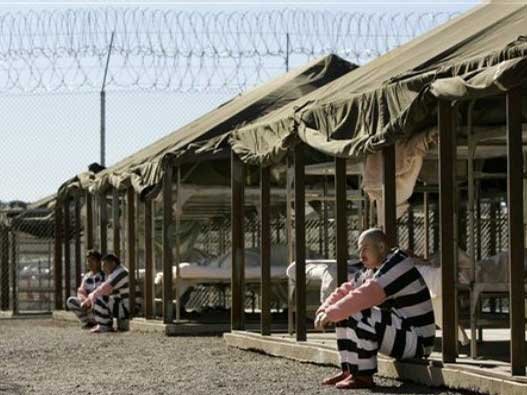

03/14/2012
Last year the federal government announced its plans for deluxe detention facilities for invasive foreigners (see Coming Soon from Obama: Illegal Alien Detention Centers with Continental Breakfasts).
That future is here, with a spiffy new detention center opening soon in Texas, and ICE honchos recently invited the media for a tour to show how much the agency had rolled over for Raza’s demands of cushy treatment for lawbreakers. (Actually, a comfy detention center opened last year in Florence, Arizona, so the new one is not unique.)
Below, the courtyard of the Karnes County Detention Center has picnic tables with gazebos providing shade from the hot sun of south Texas.

Our tax dollars at work!
Notably, ICE official Gary Mead remarked, “It was never our authority or our responsibility to punish people or correct their behavior.”
Whoa, isn’t it the government’s job to impose negative reinforcement on lawbreakers? Why should illegal aliens stop invading America when they are treated like hotel guests? The detention center (with a soccer field and gym) is certainly nicer than their home digs.
Punishment is absolutely warranted for foreign job thieves. Sheriff Joe Arpaio does a good job of making invaders feel unwelcome, as shown below.

Trying To Make Immigrant Detention Less Like Prison, NPR, March 14, 2012
Just off the side of the road in rural southern Texas is a large beige building that looks a lot like a prison. Fences and tall walls mark the outside. Inside, the doors slam and people sit in control booths at the end of long concrete hallways.
But just a little farther into the facility, the door opens to a courtyard in the center of the complex, and there, things begin to change. There’s a soccer field, a pavilion and a gymnasium. There’s also a walk-up pharmacy and commissary. All of it is guarded by officers in polo shirts.
This is the federal government’s new plan for immigrant detention — facilities built to make detention feel less like prison.
“It was never our authority or our responsibility to punish people or correct their behavior,” said Gary Mead, who is in charge of enforcement and removal operations for Immigration and Customs Enforcement. “Our authority is only to facilitate removal. So we have to treat them very differently than how the state prison system or county jail system would treat people in their custody.”
The facility is empty now, but within a month as many as 600 immigrant detainees will fill the rooms that line the courtyard. They will sleep eight to a room with a private bath, and they will be allowed to move about the facility largely unescorted.
This place is three years in the making, and it’s a significant departure from ICE’s other facilities, which critics charge are excessively harsh and lacking sufficient oversight. This facility is for low-level detainees — immigrants who have been picked up in sweeps or those seeking political asylum. For the most part, they are nonviolent people who haven’t committed any crimes, except for overstaying a visa or crossing the border illegally.
Some will be deported quickly. Others will stay for months or longer as they press their cases in an often lengthy court process.
In the meantime, Gary Mead says, they will have access to the facility’s library and can have daily visits with family — a marked contrast to other facilities.
“We have listened to and heard stakeholders across the spectrum in terms of the need to reform our system,” Mead said. “We took them seriously, and that’s what we’re doing.”
Outside in the parking lot, though, a dozen of those stakeholders — largely immigrant rights advocates — stood in a group and talked about what they saw during their tour of the facility. No one in this group said they were happy with the results.
“It’s a prison,” said Lisa Graybill, legal director of the ACLU in Texas. “It’s a clean, nice-looking prison. It really begs the question of why did they spend so much money constructing a facility like this when we know that there are alternatives and less expensive ones?
“Having one of the big private prisons run it as a profit is a mistake,” she said. “If it walks like a duck and talks like a duck …”
GEO Group, the second largest private prison company in the country, won the contract to operate this facility. The company has been sued in recent years over the conditions of some of its facilities.
But Reed Smith, GEO Group’s vice president of operations for the region, said he’s proud of what they’ve done here.
“Yes, we are a for-profit company,” Smith said. “But if we cut corners, we wouldn’t have been selected to operate a facility like this. If we ran poor operations, we’d be out of business.”
Advocates have said they don’t want a private prison group running the facility any more than they want the federal government in the business of detaining low-level, noncriminal immigrants. Many of them come from extended families or have lived here since they were children. The advocates said there are many options, like ankle bracelets, which studies have shown are significantly cheaper and successful at bringing people back to immigration court.
ICE’s Gary Mead said he plans to use more ankle bracelets in the future. But he also plans to build more facilities like the Karnes County Civil Detention Center.
“We now have more people on alternatives to detention than we’ve ever had,” Mead said. “The fact of the matter is people here are detained, and we think it’s appropriate for some groups of people.”
More than 23,000 low-level detainees are wearing ankle bracelets or other devices right now, according to Meade. But many others will come here to a place that’s not quite prison, but not a place any of them want to be.